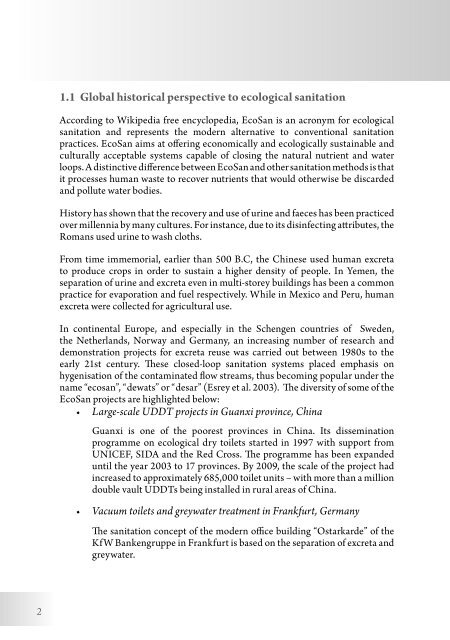Technical Guide to EcoSan Promotion
Technical Guide to EcoSan Promotion
Technical Guide to EcoSan Promotion
You also want an ePaper? Increase the reach of your titles
YUMPU automatically turns print PDFs into web optimized ePapers that Google loves.
1.1 Global his<strong>to</strong>rical perspective <strong>to</strong> ecological sanitation<br />
According <strong>to</strong> Wikipedia free encyclopedia, <strong>EcoSan</strong> is an acronym for ecological<br />
sanitation and represents the modern alternative <strong>to</strong> conventional sanitation<br />
practices. <strong>EcoSan</strong> aims at offering economically and ecologically sustainable and<br />
culturally acceptable systems capable of closing the natural nutrient and water<br />
loops. A distinctive difference between <strong>EcoSan</strong> and other sanitation methods is that<br />
it processes human waste <strong>to</strong> recover nutrients that would otherwise be discarded<br />
and pollute water bodies.<br />
His<strong>to</strong>ry has shown that the recovery and use of urine and faeces has been practiced<br />
over millennia by many cultures. For instance, due <strong>to</strong> its disinfecting attributes, the<br />
Romans used urine <strong>to</strong> wash cloths.<br />
From time immemorial, earlier than 500 B.C, the Chinese used human excreta<br />
<strong>to</strong> produce crops in order <strong>to</strong> sustain a higher density of people. In Yemen, the<br />
separation of urine and excreta even in multi-s<strong>to</strong>rey buildings has been a common<br />
practice for evaporation and fuel respectively. While in Mexico and Peru, human<br />
excreta were collected for agricultural use.<br />
In continental Europe, and especially in the Schengen countries of Sweden,<br />
the Netherlands, Norway and Germany, an increasing number of research and<br />
demonstration projects for excreta reuse was carried out between 1980s <strong>to</strong> the<br />
early 21st century. These closed-loop sanitation systems placed emphasis on<br />
hygenisation of the contaminated flow streams, thus becoming popular under the<br />
name “ecosan”, “dewats” or “desar” (Esrey et al. 2003). The diversity of some of the<br />
<strong>EcoSan</strong> projects are highlighted below:<br />
• Large-scale UDDT projects in Guanxi province, China<br />
Guanxi is one of the poorest provinces in China. Its dissemination<br />
programme on ecological dry <strong>to</strong>ilets started in 1997 with support from<br />
UNICEF, SIDA and the Red Cross. The programme has been expanded<br />
until the year 2003 <strong>to</strong> 17 provinces. By 2009, the scale of the project had<br />
increased <strong>to</strong> approximately 685,000 <strong>to</strong>ilet units – with more than a million<br />
double vault UDDTs being installed in rural areas of China.<br />
• Vacuum <strong>to</strong>ilets and greywater treatment in Frankfurt, Germany<br />
The sanitation concept of the modern office building “Ostarkarde” of the<br />
Kf W Bankengruppe in Frankfurt is based on the separation of excreta and<br />
greywater.<br />
2

















